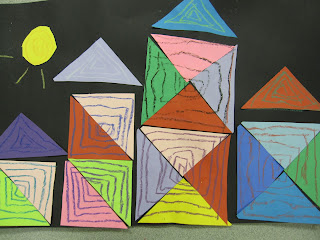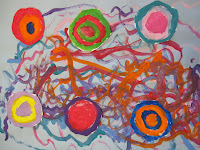Friday, March 24, 2017
Pop-Art Portraits
Fifth Grade students
looked at artwork by Andy Warhol. Warhol is famous for creating pop-art images.
Pop Art is short for popular art which means using everyday pictures or images
such as photos of celebrities or mundane things like soup cans, and turning
them into fancy museum art. Much of this type of artwork was and is used in
advertising. Students altered photos of themselves on a website called www.phixr.com, then traced their photo and
finally painted their pop-art portraits. They could only use two colors to
paint their portrait in this graphic style. They had to choose complimentary
colors (colors across each other on the color wheel) or analogous colors
(colors next to each other on the color wheel.)


Los estudiantes de
quinto grado observaron algunas obras de arte de Andy Warhol. Warhol es famoso
por crear imágenes de arte-pop, que significa usar imágenes de la vida diaria, como fotos de celebridades u objetos mundanos como
Cezanne Inspired Still Life
Second grade students compared still life artwork to portraits and landscapes. They studied the artist Paul Cezanne and painted a plate of apples that was placed at their table, in the style of Cezanne. Since we just finished an art project where students learned about Claude Monet, students also compared Monet's style to Cezanne's and discussed how artists can influence each other.
Coiled Clay Pots
Aboriginal Dot Painting
4th grade
students learned about the artwork of the aboriginal people of Australia Australia ,
just like Native Americans are indigenous to the United States
The students learned
that the Aborigines are known for their dot paintings and x-ray paintings. As
you can probably imagine, dot paintings are made with only dots, and x-ray
paintings show the inside of the subject they painted. Students chose an animal
that lives in 


Los
estudiantes de 4º grado aprendieron sobre el arte del pueblo aborigen de
Australia. Este grupo de personas son indígenas de Australia, igual que los
nativos americanos son los indígenas de los Estados Unidos.
Los estudiantes
aprendieron que los aborígenes son conocidos por sus obras de puntitos y
pinturas estilo rayos x. Como se podrán imaginar, las obras de puntitos son
pinturas hechas solo de puntos y las pinturas estilo rayos x muestran lo de
adentro del sujeto de la pintura. Los
estudiantes escogieron un animal que viva en Australia para pintar en los estilos
de puntitos y rayos x de los aborígenes. Printmaking in Kindergarten
Shape Robots
Matisse Collage
Second Grade students
looked at artwork by Henri Matisse who was known for his cut paper collages.
Students learned that Matisse started out as a painter, but later created cut
paper collages because he was sick and had to stay in bed.
Students also learned to
create balance in their artwork, to make it more interesting to look at. They
asked themselves these questions:
-Are there any spaces that look empty?
-Did I use small and large shapes?
-Do some of my shapes overlap?
-Did I use black shapes evenly?

Wednesday, March 1, 2017
Clay Castles
Fifth Grade students demonstrated their ability to roll a slab and use the score and slip method of attaching clay while creating these castles.
Dali Inspired Animals
Second Grade students learned about Spanish artist, Salvador Dali.
Students watched a brief video about surrealism (Get
Surreal! With Salvador Dali). Students discussed the meaning of surrealism, as well as where
the surrealists get their inspiration. Then they looked closely at two of
Dali's works that feature elephants with extremely long skinny legs. Students
brainstormed animals that could be drawn in this way. Students chose an animal
to create in the surrealist style.


Mouse Paint Color Wheels
First Grade students learned
about primary colors and how to mix paint to get secondary colors. They painted
mice with primary and secondary colors and glued them in the order of the color
wheel.
Tessellations
4th graders looked at artwork by M.C. Escher and learned about
tessellations. Tessellations are shapes that can fit together with any overlaps
or gaps, across a plane. First, they created a shape that would tessellate.
Then they traced this shape until it covered their paper. Finally, they
brainstormed what they thought their shape looked like and drew those details
into each shape. Then they colored their tessellations.


Tints and Shades Ice Cream
Students learned to create tints by adding white to any color. Then students learned to create shades by adding black to any color. They used this knowledge to create ice cream cones featuring tints and shades.
Kandinsky!

First Grade students looked at artwork by Wassily Kandinsky and discussed how the artwork made them feel or what the artwork made them think about. They also looked at his famous artwork "concentric circles" which is a color study to see which colors look best next to each other. Students did their own color study on six circles. They experimented with the way colors look next to each other. The next week students revisited Kandinsky's artwork and discovered that Kandinsky often painted while listening to music. Then they listened to different kinds of music to paint the background.
Monster Cityscape
Kindergarten students discussed the meaning of cityscape, as well as what shapes we can find in pictures of cityscapes. Students drew their own cityscape with oil pastel, and painted it with tempera cakes.
Then students read “Monsters Don’t Eat Broccoli” by Barbara Jean Hicks. They drew a monster and created the monster’s skin by pressing legos into stamp pads.
Fifth Grade explorations with abstract expressionism
5th graders tried their hand at abstract
expressionism, also known as splatter painting, which was invented by Jackson
Pollack. Students learned that this style of art is controversial because many
people believe it does not take talent. However, after painting in this style,
many students had a much more positive view of Jackson Pollack and his style of
painting. After all, it is very messy and fun!
Subscribe to:
Comments (Atom)

































